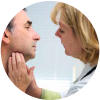

THE COMMON COLD
Adults experience an average of 2-3 colds a year.1 There is no cure for the common cold, and no medication is licensed to shorten the duration of infection.1 Treatment is therefore aimed at symptomatic relief, and includes painkillers, decongestants, cough suppressants, expectorants and mucolytics and sore throat lozenges. Sufferers may also employ comfort measures and herbal remedies.2,3

NASAL SYMPTOMS OF THE COMMON COLD
- Congestion caused by an immune response to the cold virus leading to swelling of nasal blood vessels.4
- Rhinorrhoea (runny nose) due to parasympathetic activity stimulating submucosal glands of the nasal mucosa to produce excessive nasal secretions.5
- Sneezing, which often accompanies rhinorrhoea and is thought to occur due to the stimulation of sensory nerve endings in the mucous membrane
- Sinus pressure, caused by a swelling of the sinuses which may lead to a blocked nose, pain and tenderness6

WHEN TO REFER CUSTOMERS WITH A COLD TO THE DOCTOR1
- Upper airway distress - indicated by a harsh vibrating sound while breathing, drooling, or an inability to swallow.
- Lower airway distress - indicated by laboured breathing
- Severe headache
